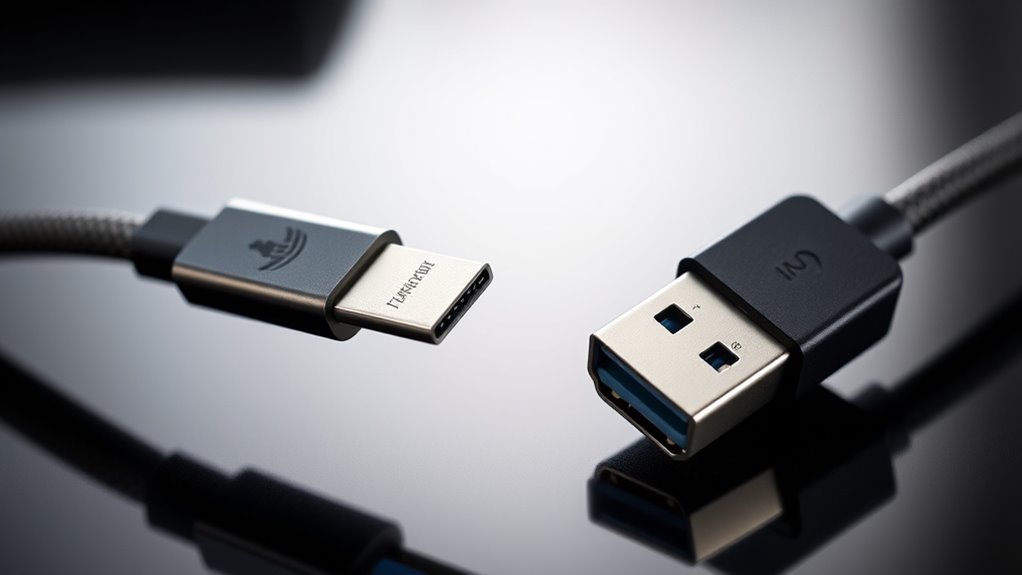Thunderbolt and USB4 both offer fast data transfer speeds of up to 40Gbps and support up to 100W of power delivery, but Thunderbolt is optimized for demanding professional tasks and provides more consistent performance. USB4, on the other hand, offers broader compatibility and flexibility for everyday devices. While they share connectors, their features differ slightly. To understand which one suits your needs best, explore the detailed differences and use cases further.
Key Takeaways
- Both Thunderbolt 3 and 4 support up to 40Gbps speeds; USB4 can also reach 40Gbps but varies by device.
- Thunderbolt provides up to 100W power delivery, ideal for demanding devices; USB4 offers flexible power options up to 100W.
- Thunderbolt ports are typically on high-end devices; USB4 uses USB-C connectors and offers broader compatibility.
- Thunderbolt delivers consistent high-speed performance suitable for professional workflows; USB4 is versatile for general use.
- Thunderbolt emphasizes maximum speed and power, while USB4 emphasizes flexibility and cost-effectiveness across a wider device range.

When choosing between Thunderbolt and USB4, understanding their differences is essential because both technologies offer high-speed data transfer and versatile connectivity, but they are not identical. One of the key factors to consider is power delivery. Thunderbolt generally supports higher power output, meaning it can deliver up to 100W of power, making it suitable for charging laptops and powering peripherals directly through the cable. USB4, on the other hand, can also provide up to 100W of power, but this depends on the implementation and the device’s specifications. Knowing this helps you decide which standard better suits your needs, especially if you want to keep your setup streamlined without multiple power adapters.
Data transfer speeds are another critical aspect to compare. Thunderbolt 3 and Thunderbolt 4 both offer maximum transfer rates of 40Gbps, making them some of the fastest options available for external devices. USB4, on the other hand, can reach speeds up to 40Gbps as well, but it’s more flexible in how it’s implemented across different devices. Some USB4 devices may operate at lower speeds, such as 20Gbps, depending on the manufacturer’s design and hardware capabilities. If raw speed is your top priority, Thunderbolt’s consistent 40Gbps transfer rate provides a reliable benchmark, especially for demanding tasks like 4K video editing or large file transfers.
Thunderbolt offers a consistent 40Gbps speed, ideal for demanding tasks like 4K editing.
Compatibility also plays a role in your decision-making. Thunderbolt devices are designed to work seamlessly with Thunderbolt ports, which are often found on high-end laptops and desktops. While USB4 shares the USB-C connector with Thunderbolt 3 and 4, not all USB4 devices support Thunderbolt’s full feature set. This means that a Thunderbolt device might not work at its maximum capabilities if plugged into a USB4 port that isn’t Thunderbolt-compatible. Conversely, USB4 offers broader compatibility with a wide range of devices, including older USB standards, which makes it more versatile for everyday use.
Ultimately, both Thunderbolt and USB4 deliver impressive data transfer speeds and power delivery capabilities, but your choice depends on your specific needs. If you require maximum speed and higher power delivery for professional workflows, Thunderbolt might be the better fit. If you want broad compatibility with decent speeds and power options, USB4 provides a flexible and cost-effective solution. By understanding these differences, you can select the technology that aligns best with your device ecosystem and performance expectations.
Frequently Asked Questions
Can USB4 Devices Support Daisy Chaining Like Thunderbolt?
No, USB4 devices generally don’t support daisy chaining like Thunderbolt. While USB4 offers excellent device compatibility and fast data transfer, it lacks native daisy chaining capabilities. If you want to connect multiple devices in a series, Thunderbolt is your best option because it supports daisy chaining seamlessly. Keep in mind, not all USB4 devices will support multiple devices in a daisy chain, so check specifications carefully.
Are Thunderbolt Ports Backward Compatible With Older Thunderbolt Versions?
Thunderbolt ports are generally backward compatible with older versions, but compatibility issues can arise without proper firmware updates. You might experience limited features or reduced performance if your device’s firmware isn’t current. To guarantee seamless connectivity, check for firmware updates from your device manufacturer. Keep in mind that while basic data transfer should work, some advanced features or daisy chaining may not function properly without the latest updates.
How Does Power Delivery Differ Between Thunderbolt and USB4?
Think of power delivery like a race where USB4 is a sprinter, providing rapid charging speeds, while Thunderbolt is more like a marathon runner, prioritizing power efficiency over quick bursts. Thunderbolt offers higher wattage for faster device charging, but USB4 balances power efficiency with decent charging speeds. If you’re aiming for quick power-ups or sustained energy, understanding these differences helps you choose the right port for your needs.
Is Thunderbolt More Secure Than USB4 for Data Transfer?
You’ll find that Thunderbolt generally offers more secure data transfer due to its advanced encryption standards, which protect your information from unauthorized access. USB4 also provides good security, but Thunderbolt’s robust encryption makes it slightly more secure for sensitive data. When choosing between them, consider your security needs—if maximum data transfer security is essential, Thunderbolt’s encryption standards give it an edge over USB4.
What Are the Cost Differences Between Thunderbolt and USB4 Accessories?
Sure, you’ll find that Thunderbolt accessories often come with a hefty price tag, making USB4 look like the budget-friendly hero. The pricing differences are noticeable, with Thunderbolt cables and docks costing markedly more due to licensing fees and higher performance standards. If you’re budget-conscious, USB4 accessories will save you money, but if speed and reliability are your game, be prepared to splurge a bit on Thunderbolt gear.
Conclusion
In the battle of Thunderbolt versus USB4, you now hold the power to choose the ultimate connector. While Thunderbolt offers lightning-fast speeds and unmatched versatility, USB4 brings incredible value and broad compatibility. Think of it as a race between a Ferrari and a reliable family sedan—you get impressive performance either way. So, whether you chase speed or savings, rest assured your device’s future is brighter than a supernova with either choice. The tech world’s never seen a showdown this epic!








